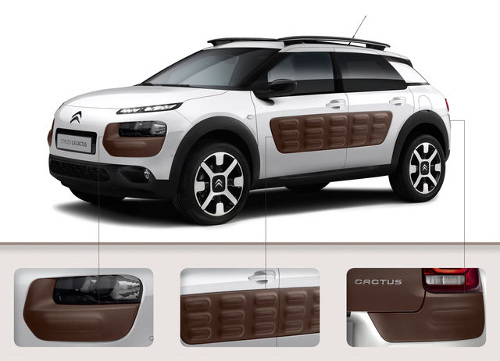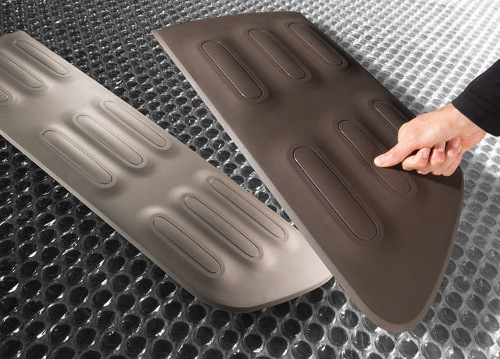 |
| December 09, 2014 | Volume 10 Issue 46 |
Designfax weekly eMagazine
Archives
Partners
Manufacturing Center
Product Spotlight
Modern Applications News
Metalworking Ideas For
Today's Job Shops
Tooling and Production
Strategies for large
metalworking plants
Wheels: Integrated exterior plastic panels aim to add style and protection
BASF has successfully optimized thermoplastic polyurethane (TPU) so that it can be applied extensively and unpainted on the vehicle exterior. The automotive manufacturer PSA Peugeot Citroen uses the new TPU grade Elastollan AC 55D10 HPM (High Performance Material) for cladding the Citroen C4 Cactus crossover vehicle, which has just become available for purchase in Europe.

The exterior panels, called Airbumps, are full of large, air-filled cushion bumpers that can come in contrasting colors. They are fitted on the sides as well as on the front and rear of the vehicle in an aim to protect the car exterior from impact and scratches. BASF credits cell phone cases and Bubble Wrap packaging as inspirations. Like them or not, they do give the vehicle a distinctive look.
This world first in extensive exterior application is the result of many years of development work between the French automotive manufacturer Citroen, the supplier Rehau-Switzerland, and BASF. Rehau manufactures the side Airbumps, while the company Faurecia-France produces the bumpers at the front and back. "With their characteristic Elastollan surface, Airbumps embody the philosophy of the Citroen C4 Cactus perfectly; they have style and are multifunctional," says Jerome Vinot Prefontaine, Purchasing General Manager for the C4 Cactus program at PSA Peugeot Citroen. "Together with BASF and the suppliers of the Airbump parts, we have shaped material development and the manufacturing process in such a way that the two have resulted in models offering the optimum combination of quality, aesthetics, and costs."

Good assembly properties
This makes Elastollan HPM an ideal surface for the impact-absorbing Airbumps, which give the C4 Cactus its characteristic style. The injection-molded Elastollan component is mounted to a polycarbonate and acrylonitrile-butadiene-styrene (ABS) support shell, thus forming flexible cavities that can be dented and then bounce back again. The entire structure is fixed to the metal chassis. Because of the good mounting properties of the HPM grade, a tight assemblage is possible, which cannot be achieved using conventional trim materials, such as polypropylene.
Another plus is that Elastollan HPM can be pigmented, so the Airbumps do not have to be painted. They do not require any special maintenance, and in case of an accident they may help reduce the repair costs for the vehicle (repair pricing not available at time at publishing). The bumpers are available in four contrasting colors (black, brown, light and dark gray) and allow automakers to follow the trend of providing seemingly "individualized" vehicle personalization via mix-and-match options when ordering. BASF has also further developed the processing properties of the new Elastollan grade. The material can be injection molded within a wide process window with a cycle time that is 50 percent shorter compared with conventional TPU. It has excellent flow properties, which means that low wall thicknesses of 1.5 mm to 1.8 mm can be produced without affecting the surface quality.
Video: Whacking Airbumps with a hammer and a shopping cart.
"Because of the high demands on surface and color, hardness and flexibility, the close cooperation with BASF in material formulation and application development was a decisive factor for us," says Bernard Delles, Project Head at the automotive supplier Rehau, which manufactures the side Airbumps.
Faurecia uses the new Elastollan HPM for manufacturing the bumpers at the front and back of the C4 Cactus. "The innovation lay not only in the material but also in the mounting," says Sebastien Bret, Development Manager at Faurecia. "BASF has developed a plastic that required a new assembly technology. We worked closely to meet the requirements for the industrial mass production of these unusual parts." Up to now, Elastollan has been used in the automotive industry mainly as cable sheathing, in the engine compartment, and in the vehicle interior (e.g., for door handles, gear knobs, and cupholder linings). BASF's TPU can be injection molded, extruded, or blow-molded. Airbump is a registered trademark of PSA Peugeot Citroen.
Find out more information at www.elastollan.basf.us.
Source: BASF
Published December 2014
Rate this article
View our terms of use and privacy policy
